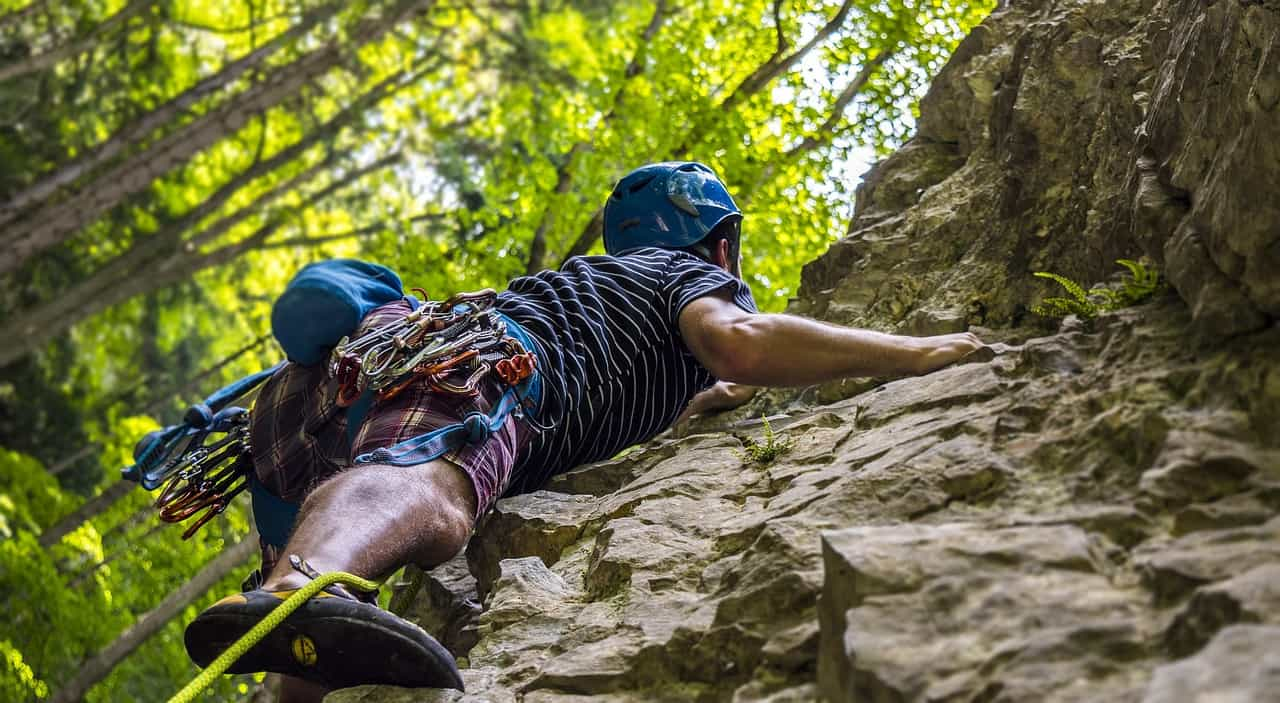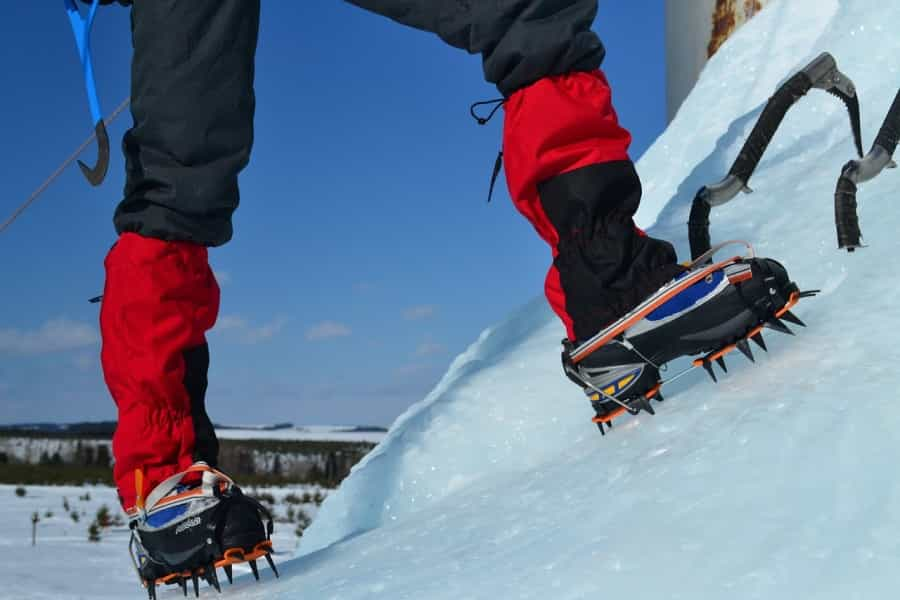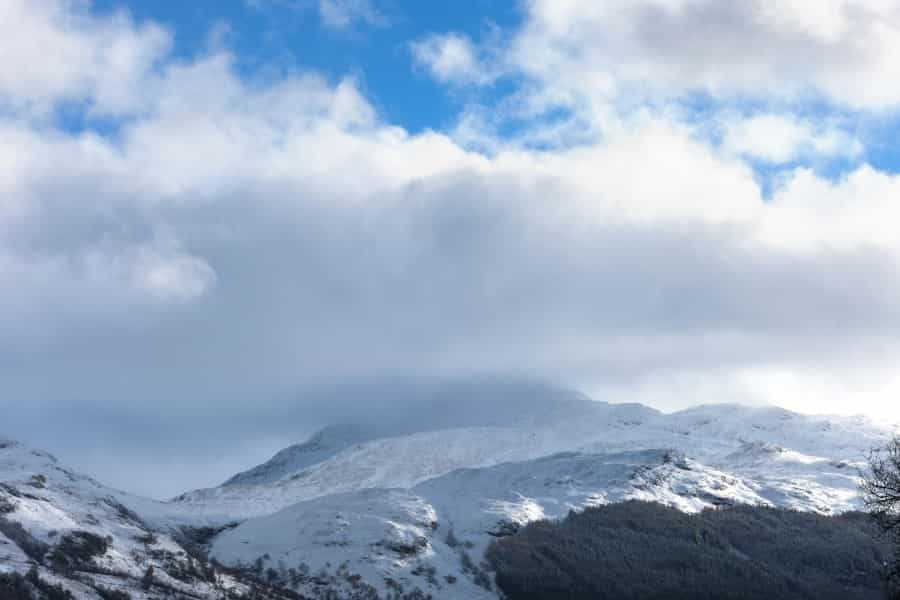Climbing in Loch Lomond & The Trossachs

With a mixture of bouldering or sport and classic climbs – from easygoing to strenuous routes strictly for the experts – Loch Lomond & The Trossachs National Park is a popular destination for climbers of all abilities, who flock to Scotland’s southernmost national park to keep fit, keep in control of their mental health and revel in the fresh air and scenery of lochs, forests and glens.
Read on to find out about Pitchup’s favourite bouldering, sport climbing and trad routes, where to practise your sport, and – most importantly – how to keep safe while out in the mountains.
One final bit of advice for climbers – if you’re out in the national park in summer, always always take some midge spray with you!
Bouldering spots in Loch Lomond & The Trossachs
Bouldering – climbing without the use of ropes and harnesses, but usually with a safety mat – is popular for honing skills and increasing fitness levels, and has really taken off in the national park in the last few years. As well as the top spots highlighted below, you could consider the boulder fields at Ben Ledi, Mini Magic Wood near Ardvorlich, and Glen Massan.
Dubh-Lic Boulders
Close to the Rest and Be Thankful Pass, this spot on the western fringes of the park offers quality climbing in a quiet location. Relatively newly opened up to climbers, Dubh-Lic Boulders are in Glen Croe, a once-glaciated valley scattered with bouldering opportunities – locally there are more than 155 routes, ranging from intermediate to expert.
There's a good parking spot just off the B828, with the boulders about 40 minutes’ easy walk from there.
Rock type: Schist
Difficulty: Intermediate
Best time to visit: Spring and early summer
Narnain Boulders
On the lower slopes of The Cobbler (also known as Ben Arthur and one of the area’s most recognisable mountains with its three craggy peaks), the Narnain Boulders are almost moon-like in their appearance, and have stunning views of Loch Lomond. Thanks to their proximity to Glasgow and its resident mountaineering pioneers, these boulders played an important role in the development of Scottish climbing. Access is from the pay-and-display car park at Succoth.
Choose between 10 climbs: for high boulders, go for The Crucifix and Two Hot Honies, and if you’re looking for slightly easier routes, attempt The Quartz Wall and Left Wall routes.
Rock Type: Schist
Difficulty: Easy to intermediate
Best Time to Visit: Late spring to early autumn
Good to know: You can combine a workout on the Narnain Boulders with a climb up to the central peak of The Cobbler – read Pitchup’s Loch Lomond hiking guide to find out how.

Sport climbing routes
Demanding physical fitness and dexterity, sport climbing takes place on short set courses with ropes and preplaced bolts to test climbing prowess and strength.
Glen Ogle
A former Scottish sport climbing hotspot, Glen Ogle is nevertheless still popular, with about 150 clubs to choose from. Bracken grows throughout the area, so be prepared for some jungle-like bushwalking on your way between routes.
There’s an impressive range of short, demanding sport climbs, including some quieter choices on the Dark Side that are often overlooked by climbers. Park in the layby directly opposite Glen Ogle Viaduct, follow the clear path over the river and then take the faint (and steep) path up to the crags.
Rock type: Schist
Difficulty: Intermediate
Best time to visit: Early spring to early summer
Good to know: Some of the routes at Glen Ogle have been affected by seepage damage so always check the bolts before embarking on your climb.
Ardvorlich Hidden Walls
Ardvorlich is a vast double-peaked crag with a range of 12 challenging technical climbs – as names like Carnage and That Sinking Feeling indicate, this is not a spot for novice climbers, but intermediates will find it excellent for honing their skills. It’s only 10 minutes’ walk from a parking spot in a roadside layby on the A82 (just don’t confuse this Ardvorlich with the Ardvorlich on the southern shores of Loch Earn).
Rock type: Schist
Difficulty: Intermediate to difficult
Best time to visit: Spring to autumn
Good to know: Anyone in your party that's not into rock climbing has the choice of two of Scotland’s Great Trails to discover: the Three Lochs Way and Loch Lomond and Cowal Way both start/end at Inveruglas, five minutes’ drive away.
Traditional climbing routes
Performed in pairs without ropes, trad (or ‘free’) climbing involves the placement of chocks and bolts up a route by the climb leader rather than relying on a pre-prepared ascent.
Ben A’an
Standing on the banks of Loch Achray, Ben A’an offers approximately 30 short but demanding trad routes, many of which have superb views over tranquil Loch Katrine in the middle of The Trossachs forestry land. More rocky crags around Creag Mhor have been revealed since tree felling in 2015/16. Park in the large pay-and-display car park.
Rock Type: Schist
Difficulty: Easy to difficult
Best time to visit: Spring to autumn
Good to know: As well as having a mix of trad climbing routes, this easily accessible mini-mountain is known as an excellent introduction to hillwalking, with a clear stepped path leading up to its peak – the whole round trip takes about 2.5 hours, and it's a good option for a walk with kids.

Creag Tharsuinn
Popular with advanced and confident climbers accustomed to winter conditions, this crag is on the north-east ridge of Beinn Narnain, and known for around 35 well-maintained high-grade routes on steep rock. Always check the local weather before attempting this climb, particularly in winter, when you should watch for a freeze and overcast skies. There's a car park at the northern head of Loch Long.
Rock Type: Mica schist
Difficulty: Intermediate to difficult
Best time to visit: All year; popular when winter conditions are right
Winter climbing
The sheer exhilaration of climbing in Loch Lomond & The Trossachs in winter is what keeps people coming back. However, clear, sunny days and the crunch of snow underfoot also bring with them the threat of ice, heavy rain and a very minute risk of avalanche, with conditions sometimes changing fast and furiously. Mountaineering Scotland has launched the ThinkWinter campaign to help you enjoy winter in the mountains safely, without putting you or your fellow climbers in danger.

Indoor climbing walls
There are no indoor climbing options within the boundaries of the national park, but there are three hotspots in Glasgow (half an hour by car from Loch Lomond) if you need to resharpen your skills before hitting the mountains; the climbing centres also provide an excellent introduction to the sport for first timers and youngsters. They are:
- The Prop Store and The Newsroom, both run by The Climbing Academy
Outdoor shops
Buy climbing gear and outdoor clothing in concessions at Antartex Village, at the southern end of Loch Lomond, in Callander climbing stores and at The Green Welly Stop just north of Tyndrum.
You can also buy maps and climbing guides online from The Trails Shop.
Beyond climbing
With outdoor climbing throughout the year and Munros to bag for all skill levels, Loch Lomond & the Trossachs National Park makes a great destination for outdoor breaks – if you’re not quite confident enough to tackle the routes listed here, check out our Loch Lomond walking guide for some gentler routes in the national park.
Have a look at Pitchup’s range of campsites around Loch Lomond, which give you a head start on getting onto the hills early in the day. Always take heed of the Scottish Outdoor Access Code when out and about in the national park, and if you decide to wild camp – which is largely legal in Scotland – please be aware of local regulations, which include needing a permit to camp in certain areas of the national park to preserve its fragile environment.